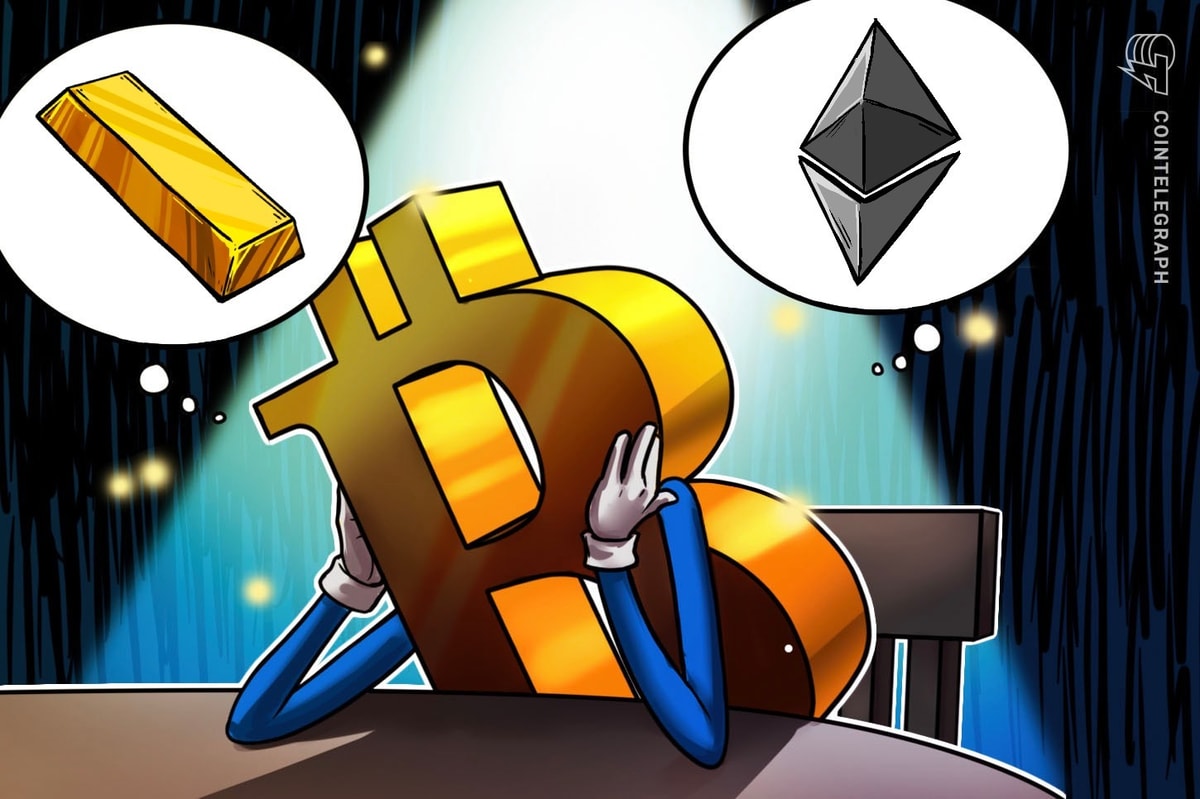In a few years, finance wonks and crypto advocates will look back to 2024 and agree that it was the year Bitcoin went mainstream and saw mass adoption within traditional finance. The incredibly successful launch of the spot Bitcoin ETFs, MicroStrategy CEO Micheal Saylor’s plan to buy $42 billion in Bitcoin and Bitcoin rallying to a new all-time high are just a few of the major milestones of the year.
Bitcoin (BTC) is officially in the big leagues and deep dives into how BTC’s integration into all aspects of finance are a frequent topic of discussion by analysts and thought leaders at crypto conferences and on social media. In order to get a better understanding of the ramifications of Bitcoin and crypto’s integration into traditional finance, Cointelegraph spoke to Brian Russ, the chief investment officer at 1971 Capital.
Cointelegraph: Institutional and retail investors are buying shares of the spot Bitcoin ETFs, but further down the road, how do you see BTC being integrated into investment portfolios?
Brian Russ: I absolutely think it will be the case where you’ll see wealth management firms and asset management firms start to show to their client base that had they diversified into Bitcoin or a combination of Bitcoin and Ethereum within their 60/40, that it would have enhanced their returns dramatically. And I think as that research starts to come out, those big registered investment advisers are going to push their customers into getting off of zero.
VanEck was one of the first to kind of fire shots on this. They were out with a research report probably as far back as six months ago, just after the Bitcoin ETF launched. Unsurprisingly, the Bitcoin Spot ETF and it showed exactly this. It was essentially a histogram that showed the traditional 60 over 40 has given you about a 9% return. But had you allocated to a combination of Bitcoin and Ethereum (ETH) and they looked at different allocation levels, the top allocation level was 7%. So had you done 60% equities, 33% bonds and 7% Bitcoin and ETH, instead of the 9% return, you would have earned a 17% return.
Crypto allocation outcomes to a traditional 60/40 portfolio. Source: Brian Russ
So that's pretty compelling, right? And I think as you see more of this research come out, you’ll see more, whether it’s individuals, family offices, institutional investors who are sitting on the sidelines say, look, let's put half a percent in or let's put 5% in.
Related: MicroStrategy’s $42B Bitcoin bet is bullish for shareholders — Analyst
Cointelegraph: What will it take to send Bitcoin price to $100,000 and above?
BR: I think you really need a catalyst to see that kind of upside move. I wouldn't expect it just to happen purely because demand starts to outstrip supply. That can happen, and we can grind above $70,000, but I don't think we're going to have a runaway breakout without some kind of catalyst. The election could be that catalyst. I'm skeptical because it's a known event with a predicted outcome that is being kind of priced into markets right now. So I think if the outcome of the election was going to be the driver, we'd see the breakout happening now versus, you know, on Nov. 5 or Nov. 6, but it could be something that follows the election. It could be policy that follows the election or it could be something else. So for me, it's kind of like eyes wide open on what is that catalyst to move Bitcoin in the broader market higher. I don't expect that we're just going to see it break to new all-time highs and then just run away like we've seen in the past.
Cointelegraph: Why are gold and silver also hitting new highs alongside Bitcoin?
BR: I think you've got to separate out speculative commodities like precious metals and then utility commodities like gold and copper. Let's say, for example, if we focus in on the precious metals market. I think it's really a big part of this more or less anti-dollar trade. So what I think confuses people is that, we oftentimes think of gold and silver as hedges and risk-off types of instruments. But if you look back through history, that really hasn't been the case.
There were massive sell offs in the precious metal markets in 2008, as well as in March of 2020. So they can actually be sources of liquidity during those periods of time when assets are sold in the face of a crisis. And what I've noticed over the years is that gold and silver have their own set of drivers. They don't often act like hedges, per se. They're not really that insurance policy. Traditionally, we've seen the US Treasury market and US dollars serve as better hedges to crisis or recession. And what's interesting to me about the precious metals market is if you go all the way back to the dollar unlinking from gold back in 1971. I think we are now right smack in the middle of the third bull market in precious metals.
It's difficult to say where you would mark the start of this precious metals bull market, but I think it's reasonable to say that March of 2020 is a good time, right? Because we had this once in 100 year viral pandemic crisis followed by the bazooka stimulus. And so that was a ton of money that was just pushed into the system. I think we expanded M2 by something like 50% over the course of 18 to 24 months with all the stimulus as well as the monetary policy that the Federal Reserve was engaged in. And I think we're probably about midway through that story.
So that puts us about 4 or 5 years into what could be a decade-long bull market in precious metals. I think when you combine the factors around COVID-19 and the stimulus-response, the fiscal deficits that we touched on, the presidential election, which we expect to be a catalyst for deeper fiscal deficits, these sort of Lyn Alden, nothing stops this train dynamic of deeper and deeper deficits, of this becoming a reflexive thing. I think you've got really just a sentiment shift around the dollar as a store of value assets. And so there's more space for competition here. And precious metals are one part of that competition. And, of course, Bitcoin has been another exciting part of that competition as well.
Cointelegraph: At ETHDenver, you presented an interesting framework for analyzing Ethereum’s current and future valuation. ETH has been a laggard in terms of its value during this cycle, but based on your methodology, do you think ETH is still on track?
BR: Yes, I do. I actually like it more here than I did at ETHDenver, which would have been in February of this year. I try to look at a confluence of factors that cross over fundamentals. Sentiment, positioning, liquidity and technicals. And when I look across those factors, I think things are slightly better now than they were back then. You know, the fundamental story to me remains intact. If you look at daily active wallets across the L1's, they're up something like 800% over the last 3 to 4 years. That was some research that Dan Tapiero had done. If you look at the recent A16z State of Crypto report, they've got L1 monthly active crypto addresses interfacing with L1 at 220 million, which is an all-time high and kind of increasing at an increasing clip.
Monthly active crypto addresses hits 220 million. Source: a16zcrypto
If you look at some of the developments as it relates to the Ethereum infrastructure, transaction fees are way down. Obviously, the shift from proof-of-work to proof-of-stake is significant. That happened a few years ago, so if you look at the fundamentals, the story just continues to get better. If you look at the price, like technicals, it's been relatively weak compared to, let's say, Bitcoin. So the ETH to Bitcoin cross or compared to Solana, which is Ethereum's top competitor, at least in market cap terms. You know, sentiment just follows price, so right now, I think we're in a negative sentiment period for Ethereum.
And the narrative is L2's are parasitic and that there are some real challenges to the Ethereum roadmap. I think some difficult and good questions are being asked. I am, however, despite having presented a traditional valuation model and having spent the vast majority of my career in TradFi, not convinced that fundamentals are really the key driver right now.
I think we’re still pretty early stage with this technology where it requires some seeing in the dark. There's a potential monetary premium to some of these assets, where Ethereum can be looked at as a solid piece of collateral that can be used within DeFi or other pockets of the blockchain ecosystem generally. And then I think you could go so far as to say there’s a memetic premium that could be added to a lot of these assets.
So what’s the memetic premium of Vitalik and the Ethereum ecosystem? The community of people? I mean, if you go around to any of these conferences, there are a lot of them are sold out. There’s just a ton of sponsors, a ton of money, a ton of people, a lot of energy, a lot of developers. All those metrics by every fundamental metric, things get better in the ecosystem. I think the roadmap is going to take time. Time will tell if the L2 scaling solution is the right solution for Ethereum. And if it's not, I think the protocol and the foundation are smart enough to know that they'll pivot it.
This article is for general information purposes and is not intended to be and should not be taken as legal or investment advice. The views, thoughts, and opinions expressed here are the author’s alone and do not necessarily reflect or represent the views and opinions of Cointelegraph.








